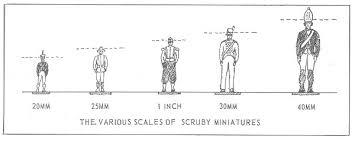
The Definitive Guide to Miniature Figure Scales in Wargaming
Share
The Definitive Guide to Miniature Figure Scales in Wargaming
When stepping into the fascinating world of miniature wargaming, one of the first decisions you'll encounter is choosing the right scale for your figures. Scale plays a pivotal role in how your game looks, feels, and plays. It influences the aesthetic appeal of your tabletop battles, the storage and cost of your miniatures, and even the tactical depth of your games. Whether you’re a beginner or a seasoned wargamer, understanding the different scales and their implications is essential for getting the most out of the hobby.
In this blog post, we’ll explore the various scales used in miniature wargaming, the advantages and disadvantages of each, and how to decide which scale is right for you. We’ll also dive into the history of miniature scales, popular scales for different genres, and tips for mixing and matching scales in your games.
1. What is Scale?
In wargaming, "scale" refers to the size of the miniatures relative to their real-world counterparts. It’s typically expressed as either a ratio (e.g., 1:72) or a height measurement (e.g., 28mm). These scales determine the physical size of the figures, vehicles, and terrain pieces used in your games.
- Ratio Scales: Represent how many times smaller the miniature is compared to the real-life object. For example, a 1:72 scale means that the miniature is 1/72 the size of the real thing.
- Height Scales: Represent the approximate height of a standard human figure, usually measured from the base of the feet to the eye level (or top of the head, depending on the manufacturer). For example, a 28mm figure represents a human roughly 28mm tall.
Understanding these scales is key to selecting miniatures that fit the aesthetic and practical needs of your wargame.
2. Popular Scales in Miniature Wargaming
6mm (1:285 to 1:300 Scale)
6mm miniatures are among the smallest used in wargaming, ideal for large-scale battles where players command entire armies or divisions.
-
Advantages:
- Perfect for mass battles and grand strategies.
- Affordable, allowing players to build massive armies without breaking the bank.
- Minimal painting effort, as the smaller size means fewer details to worry about.
- Compact, making them easy to store and transport.
-
Disadvantages:
- Lack of detail compared to larger scales.
- Can be harder to distinguish individual units, especially for players with limited eyesight.
6mm is often used for historical wargaming, such as Napoleonic battles or World War II tank combat, where large-scale engagements are key.
10mm (1:144 Scale)
10mm miniatures strike a balance between the mass appeal of 6mm and the detail of larger scales.
-
Advantages:
- Good compromise between size and detail.
- Allows for large battles while maintaining a reasonable level of miniature detail.
- Easier to paint and identify than 6mm figures.
-
Disadvantages:
- Not as widely available as 15mm or 28mm.
- Limited variety of miniatures compared to other scales.
10mm is popular for historical and fantasy wargames, such as large-scale medieval battles or World War II skirmishes.
15mm (1:100 Scale)
15mm is one of the most versatile and widely used scales in miniature wargaming. It’s particularly favored for historical games and some sci-fi settings.
-
Advantages:
- Strikes a great balance between visual appeal and the ability to field large armies.
- Easier to paint than smaller scales, with enough detail to be rewarding.
- Affordable and widely available.
- Works well for both skirmish and large-scale battles.
-
Disadvantages:
- Less detailed than 28mm figures.
- Terrain and vehicles need to match the scale, which can increase the cost.
15mm is commonly used in games like Flames of War (World War II) and De Bellis Antiquitatis (ancient and medieval battles).
20mm (1:72 Scale)
20mm is a scale often favored by historical wargamers, particularly for World War II and modern-era conflicts.
-
Advantages:
- Excellent for capturing realistic proportions.
- Compatible with many model kits and diorama accessories.
- Offers a good balance between detail and playability for skirmishes and small battles.
-
Disadvantages:
- Less commonly supported in mainstream wargaming systems.
- Larger size means fewer units on the table for large battles.
20mm is a favorite among players who enjoy crafting realistic battlefields and vehicles.
28mm (1:56 Scale)
28mm is the most popular scale in miniature wargaming, used in a wide range of genres including fantasy, sci-fi, and historical games.
-
Advantages:
- Highly detailed, making miniatures visually stunning.
- Widely supported, with extensive ranges of figures, terrain, and accessories.
- Works well for skirmish games and moderate-sized battles.
- The "heroic scale" style exaggerates certain features, making miniatures easier to paint and recognize on the table.
-
Disadvantages:
- More expensive per miniature compared to smaller scales.
- Larger figures require more storage space and bigger tables for gameplay.
28mm is the standard scale for games like Warhammer 40,000, Age of Sigmar, and Bolt Action.
32mm (Heroic 28mm)
32mm is an increasingly popular scale that builds on the 28mm aesthetic, often used for modern sci-fi and fantasy games.
-
Advantages:
- Even more detailed than traditional 28mm.
- Popular in skirmish-style games where the focus is on a few well-detailed miniatures.
-
Disadvantages:
- Can feel oversized next to traditional 28mm models, limiting compatibility.
- Terrain and vehicles need to scale up, increasing cost and storage needs.
Games like Star Wars: Legion and Infinity utilize this scale to great effect.
3. Choosing the Right Scale
The "best" scale for your wargaming needs depends on several factors:
1. The Type of Game
- Mass Battles: Smaller scales like 6mm and 15mm are ideal for large-scale battles with hundreds of units.
- Skirmishes: Larger scales like 28mm and 32mm are better for small-scale battles where individual characters and their details take center stage.
2. Aesthetic Preferences
If you’re drawn to intricate details and want your miniatures to pop on the tabletop, larger scales are the way to go. If you prefer the spectacle of huge armies clashing, smaller scales may be more satisfying.
3. Budget
Smaller miniatures are generally cheaper, allowing you to build larger armies for less money. Larger miniatures can be more expensive but are often more rewarding for painters and collectors.
4. Storage and Space
Consider how much storage space you have and the size of your gaming table. Larger scales require more room for both gameplay and storage.
5. Availability
Certain scales are more popular in specific genres. For example, 28mm dominates the fantasy and sci-fi markets, while 15mm is more common in historical wargaming.
4. Mixing Scales in Wargaming
While most wargamers stick to a single scale for consistency, mixing scales can sometimes enhance your games.
- Terrain: Using smaller-scale buildings or distant objects can create the illusion of depth on your tabletop. For example, a 15mm building could represent a distant structure in a 28mm game.
- Vehicles and Monsters: Oversized vehicles or monsters from smaller scales can be repurposed as "epic" units in larger-scale games.
When mixing scales, be mindful of maintaining visual coherence to avoid breaking immersion.
5. Historical Context: How Scales Became Standardized
The wargaming hobby has a rich history, and the evolution of scales is closely tied to the growth of the industry. Early wargaming pioneers like H.G. Wells (author of Little Wars) used 54mm toy soldiers, which were common at the time. Over the decades, scales shrank to make games more practical, with 28mm emerging as the dominant standard due to its balance of detail and playability.
The advent of plastic injection molding and 3D printing further expanded the variety of scales available, making it easier for gamers to choose miniatures that fit their needs.
6. Conclusion
Choosing the right scale for your wargaming adventures is about more than just size—it’s about finding the perfect balance of aesthetics, gameplay, and practicality. Whether you’re commanding massive armies in 6mm, leading detailed 28mm heroes into battle, or exploring futuristic skirmishes in 32mm, the scale you choose will shape your gaming experience in profound ways.
Take the time to experiment with different scales, consider the type of games you want to play, and most importantly, have fun. After all, miniature wargaming is about creating epic battles and memorable moments, no matter the size of the figures.
Try these titles for an engaging experience:
